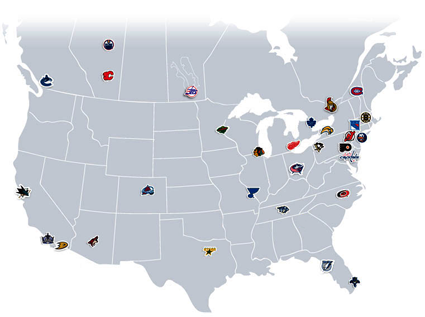When I was in college, I took a Geography course where we were tasked with re-designing the United States taking into account regional qualities. We could use whatever factors we wished; food, demographics, political leanings, or economies to recreate (and rename) the nation. I distinctly remember calling the southeastern portion of the United States ‘Redneck Villa’ and the Northwestern United States ‘Starbucks.’ While some of my designations may seem to lean heavily on negative or positive stereotypes it was a fun exercise and the ideas our class came up with were quite different from group to group. Geographers can use survey data to identify all different kinds of perceptual and formal regions. After all, its all about organizing data right? When this data is displayed on a map, the results can be both profound and informative. For example, this map you see below tracks the common ‘word’ used for soft drinks by each county in the United States.
As you can see, its not as cut and dry as one may think. The History Channel even examined this phenomenon on How the States Got Their Shapes. For hockey fans, they’ve often experimented in this manner as they attempted to imagine division re-alignment. The primary reason for these ‘concepts’ varied from wanting to maintain or enhance rivalries, shorten travel, or whatever reason they see fit. At times it was an attempt to restore divisions from the past. I remember the Smythe, Norris and Patrick divisions of old. Sometimes these divisions seemed to make a lot of geographic sense but they also had a few instances where you were truly puzzled as to what the heck someone was thinking. Occasionally its just a matter of circumstance, as was the case with the Calgary Flames who had to play the 1980-81 season in the Patrick Division with fellow division foes the New York Islanders, New York Rangers, Philadelphia Flyers, and the Washington Capitals after having moved from Atlanta. For a second time, a similar fate awaits the reborn Winnipeg Jets who will play this season in the Southeast Division. Yet as was the case with the Flames it will be a lone season of long distance misery before it gets a new divisional home. The NHL is using this as an opportunity to give itself its own extreme division makeover. There is no Ty Pennington, or heartwarming story and with no official direction just yet but news of this change has NHL fans buzzing and like my Geography class experience the variety of ideas flying around cyberspace are many. So what does this mean for the Wild (most likely)?
Click on “Read More” for the rest of the article…
On June 23rd, 2011, NHL Commissioner Gary Bettman proposed a dramatic change to the league’s current 6-division landscape. Bettman’s idea was for 4 divisions based more closely on Geography as a way to cut down on strain by timezones hopefully mitigating some of the distance traveled to play games within the division. As a fan of the Wild who are currently in the Northwest Division where it means you can have games played in either the Central or Pacific timezone as much as some of those rivalries have been fun to be apart of the travel and changes in timezone is a huge strain on teams, players and fans. Bettman did not really get into what teams go where in his grand re-alignment but fans and other experts are filling in the void rather quickly. Yet in an ironically Wild twist, Wild owner Craig Leipold may have divulged the league’s plans in an interview he gave on the team’s new radio home, KFAN here. In most theorized proposals the Wild will be playing in a Central Division. The one that most Wild fans are hoping for is a division that more or less restores the old ‘Norris’ Division foes of St. Louis, Chicago, along with Colorado, Winnipeg, and Dallas. Most experts believe the Detroit Red Wings will use this as their opportunity to move to the Eastern Conference; something they’ve been vocal about wanting the last few seasons. The Columbus Blue Jackets are another team that would like to move to the Eastern Conference but they have nowhere near the same influence in league circles as does Detroit and the Illitch family. Many proposals show Columbus also included in this new division. Even though the realigned NHL picture I have above me shows, the Nashville Predators also moving east, from a regional perspective it may help stir up some interest with other southern based clubs in the Southeast. I have a feeling Carolina and Nashville could be great rivals rather quickly. Many feel that realignment was put off until the start of the 2012-13 season because of possible developments with the Phoenix Coyotes whose chances of staying in Glendale are still rather precarious (at best). If a team, whether its the Coyotes or otherwise relocates to Quebec (which seems to be the next logical relocation candidate in this writer’s opinion) that could mean Columbus could be stuck in the Central for quite a while. The Blue Jackets will probably tout being in the East means Nashville (located in the central timezone) should move to the west which they probably would not mind too much. At this point, it is still all speculation.
So is NHL realignment good for teams and its fans?
This is really the most important question, that by as far as I can tell has seldom been asked. I realize that realignment at this point is basically a done deal, its just a matter of working out the details so perhaps it hasn’t been asked as much since some figure ‘what’s the point’ of questioning it. To answer it from a team perspective I think they would have to agree its a good thing. Losing Detroit does hurt the prestige of the Western Conference, but since they were just one of two teams in the Western Conference stuck in the Eastern timezone it made sense to move them. Columbus may feel left out, but I guess its a matter of league seniority and let’s face it, the Red Wings have the clout within the league to call its shot. From a logistics point of view, it makes travel within divisions perhaps a bit more economical, but it also more closely fits timezones which also makes travel a lot easier to deal with for those clubs not located in the Eastern Conference which still utilize just a single timezone. For fans, the timezone fit makes inter-division games far easier to accommodate. As any Wild fan can tell you, inter-division trips to Vancouver meant you didn’t start watching games until 9:30PM and if you’re working a typical 7-4 or 8-5 workday that made those mornings start awfully early when you weren’t hitting the hay until almost 12:30AM. Wild fans did not seem to mind playing Canadian opponents, ratings-wise as perhaps other American markets but the late starts can really wear on you. Western Conference clubs will still have to make the occasional West Coast trip (with its late starts) but no longer will inter division play be such a strain for teams like Minnesota and Dallas who hated playing in divisions with 3 timezones represented. I am sure that as much as fans hated those late games, so did advertisers because they knew that only the die hards are going to stay up to watch or they’ll simply record it on their DVR and thus skip the commercials.
Realignment may diminish some of the rivalries that have been created over the years. Perhaps most notably the rivalry between Original 6 franchises in the Red Wings and the Chicago Blackhawks. I have little doubt those games will still be rather spirited but as I mentioned before in my article about the establishment of a Big 10 hockey conference, those games will lose a little bit of their flavor when position within a division is not on the line. I do not mind the thought of seeing the Vancouver rivalry diminish; I think no matter what Wild fans will still have a bit more intensity for that match up but like Chicago and Detroit it may not be as visible of a rivalry on the ice. Canucks fans / players can say what they wish, a rivalry certainly existed as games were often chippy and full of fairly well-remembered incidents which occasionally demanded retribution. The lack of acknowledgement of this rivalry was simply another act of disrespect by their team and its fans, yet we’re not going to start any riot over it anytime soon. Besides, as many former North Star fans can attest to, the rivalries of the old Norris Division were some of the best in pro sports. It will be a great chance to re-kindle some of the hatred that the State of Hockey used to have for some of these cities.
If realignment is as successful as I suggest it likely will be, this could very well be Gary Bettman’s biggest legacy apart from the 2 lockouts. While I doubt Bettman will ever be free from boo’s and jeers he has made some positive moves to change the game. As was the case with opening up the game by eliminating the two-line pass and putting forth a more concerted effort to eliminate obstruction has created a more entertaining product. If a slight reduction in the travel and transitioning from timezones makes for teams having more energy its hard not to believe that the game will be any worse because of that, if not better. Even if you may be still annoyed about the instigator rule, at least give Bettman credit for seizing the opportunity to make a significant change that puts more logic in the league’s divisions than has existed the last 10 seasons.
The AHL will also realign itself in 2012-13

Perhaps not wanting to be left out, the AHL has decided to go ahead with its own reallignment but interestingly enough its taking the old NHL approach. Instead of condensing down to 4 divisions as the NHL is doing, it is going to six divisions. These new divisions have been made mainly to address travel, which is now a fairly big issue since the AHL nearly goes from coast to coast going as far as British Columbia. Like the NHL, most AHL clubs are located in the Northeastern United States so it does create a bit of a logjam in that portion of the league. It has led to some strange, but basically unavoidable anomalies as you can see with the Charlotte Checkers being placed into the Midwest Division along with the Rockford Ice Hogs, Chicago Wolves, Peoria Rivermen, and the Milwaukee Admirals.
From a financial perspective, its imporant for the American Hockey League to try to keep its costs down. Especially so, since the league now has been able to maintain 30 teams, giving each NHL team its very own affiliate to work with. While the travel isn’t exactly quite like Slap Shot, the finances are trim enough its travel by coach instead of by chartered flight. The AHL recently decided to shrink its regular season schedule to 76 games instead of the 80 it had the last few years, as well as shortening the 1st round of the playoffs to a best of 5 series instead of a best of 7. Finances played a role in this as well as the strain on players who often found themselves playing 4 games in 5 nights, normally structured around the weekends.
For the Wild’s AHL affiliate, the Houston Aeros will probably embrace the reduced amount of travel within their division as it will place the Oklahoma City Barons, the Abbotsford Heat, as well as fellow in-state rivals the Texas Stars, and the San Antonio Rampage. This does mean the Aeros will no longer be in the same division with former IHL foes Milwaukee, Grand Rapids and Chicago which were some of the clubs best rivalries but I am sure they’ll welcome the overall reduction in travel. With the Manitoba Moose effectively pushed out of Winnipeg and relocated to St. John’s Newfoundland, Abbotsford will be Western Canada’s lone representative and it will be interesting to see if they can keep it going now that they’re playing in a division with a collection of teams from the south central U.S.
Here are the new AHL Divisions: *their NHL affiliation in parentheses
EASTERN CONFERENCE
Atlantic Division:
Manchester Monarchs (Los Angeles)
Portland Pirates (Phoenix)
Providence Bruins (Boston)
St. John’s Ice Caps (Winnipeg)
Worcester Sharks (San Jose)
Northeast Division:
Adirondack Phantoms (Philadelphia)
Albany Devils (New Jersey)
Bridgeport Sound Tigers (NY Islanders)
Connecticut Whale (NY Rangers)
Springfield Falcons (Columbus)
East Division:
Binghamton Senators (Ottawa)
Hershey Bears (Washington)
Norfolk Admirals (Tampa Bay)
Syracuse Crunch (Anaheim)
Wilkes-Barre/Scranton Penguins (Pittsburgh)
WESTERN CONFERENCE
North Division:
Grand Rapids Griffins (Detroit)
Hamilton Bulldogs (Montreal)
Lake Erie Monsters (Colorado)
Toronto Marlies (Toronto)
Rochester Americans (Buffalo)
Midwest Division:
Charlotte Checkers (Carolina)
Milwaukee Admirals (Nashville)
Chicago Wolves (Vancouver)
Peoria Rivermen (St. Louis)
Rockford Ice Hogs (Chicago)
West Division:
Abbotsford Heat (Calgary)
Oklahoma City Oil Barons (Edmonton)
Texas Stars (Dallas)
San Antonio Rampage (Florida)
Houston Aeros (Minnesota)
Add The Sports Daily to your Google News Feed!











